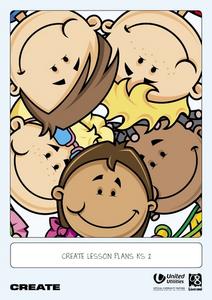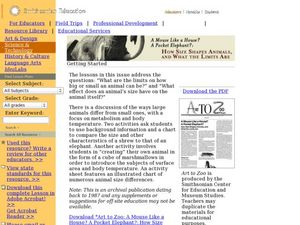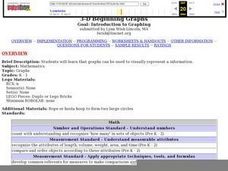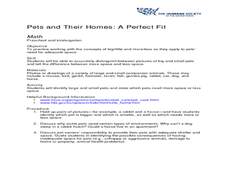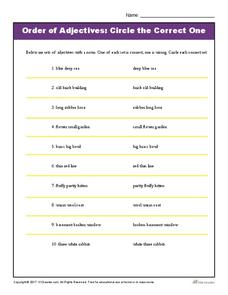John Talavera
Autism iHelp – Opposites
In/out, up/down, big/small; understanding opposites is a fundamental vocabulary-building skill. This app uses real-life photographs, to introduce the learner to the concept of opposites. Learning opposites is necessary for understanding...
Curated OER
Children's Literature and the Bill of Rights
Students read a variety of well-known studenT books and discuss concepts presented in the books as they relate to the Bill of Rights. They discuss the books and compare them to the Bill of Rights Amendments.
Curated OER
Fractions And Integers Review
Investigate the concepts of fractions and integers in order to review for a future assessment. The teacher reviews the major concepts with the class and provides help throughout the lesson as needed. Math middle schoolers work together...
Curated OER
Newton's Second Law of Motion with Simple Machines
First graders study Newton's Second Law of Motion before demonstrating the concept with a simple machine. They sing a song about speed, force, mass, and acceleration. They use simple machines to demonstrate how objects that have a higher...
Curated OER
Animals and Plants: 1st Grade Science
First graders will have a better grasp on animal characteristics after viewing this presentation. The concepts covered are, skin, life cycle, offspring, size, and human/animal interrelationships. Note: This is good as a concept review or...
Curated OER
Saving Energy And Climate Change
Students engage in a lesson that is focused upon the concepts of energy and its relationship to climate change. They focus upon the production of greenhouse gases and global warming. Students discuss the climate of different parts of the...
Curated OER
Shining The Love on Reading!
Students enjoy reading independently. In this independent reading concept, students are given a finger flashlight to make silently reading a book at their instructional level more enjoyable.
Curated OER
What is Language?
Intended to be used along with the first chapter of An Introduction to Language textbook, this PowerPoint is full of linguistic terminology that is not necessarily explained. This tool can be used to complement a lecture or a text, but...
Curated OER
How Size Shapes Animals
Students investigate how size affects large and small animals differently. In this animal lesson plan, students determine how size affects different animals by constructing their own animal out of marshmallows. Once students create...
Curated OER
Following in Their Footsteps
Students explore the concept of philanthropy. In this service learning lesson, students reflect upon the lesson of tikkun olam as they read "First They Came for the Jews." Students plan and execute a tikkun olam project of their choosing...
Curated OER
Cranes, Crosswalks, and Big Gulps
Learners watch a video and answer questions based on wildlife jobs. In this wildlife lesson plan, students learn that biologists don't just play with animals but that there is a lot of study involved.
Curated OER
Big Beans, Little Beans
Students measure and note the variation in the lengths of lima beans. They compare the growth rate of different sized beans.
Innovative Mobile Apps
Action Words
From asking to yelling, this app teaches action verbs through images. Users listen to each word and tap the picture that corresponds with that verb. Just touch the screen to get started!
Curated OER
3-D Beginning Graphs
Students explore the concept of big and small. They collect objects from the classroom, sort them by size, and create a graph using Duplo stacking blocks.
Curated OER
Pets and their Homes
Students explore the space needed for an animal to live in. In this pets lesson plan, students view pictures of animals and decide which one needs more space or less space to live. Students discuss animals environments and why certain...
Curated OER
Tessellations WOW!
Students identify and manipulate shapes to create tessellations. In these geometry/spatial relations lessons, the students use of a variety of modalities such as literature, music, writing, and art as introductions to the concept of...
Facing History and Ourselves
Eyes on the Prize Lesson 2: Six Steps for Nonviolent Social Change
Students explore the concept of nonviolent protest. For this Civil Rights lesson, students examine the attributes of nonviolent protest as they investigate the student protests that took place in Nashville in 1960-1961. Students reflect...
Curated OER
Weather Forecasting
Fourth graders explore the concepts of weather forecasting. Students locate the current weather in a specified city. In groups, they record the specified weather information and make predictions of weather. Students justify their...
Curated OER
Ocean Exploration
Students explore whales. In this animal adaptation and whale lesson, students access prior knowledge about whales from previous lessons, then use background knowledge to predict the eating strategies of a baleen whale and a toothed...
Curated OER
Becoming More Comfortable in Your Inherited Skin
Students examine their concepts of "beautiful" and "ugly" and the social influence on this perception. They look more closely at the role genetics plays on determining the way a person looks. Students explore ways to enhance their own...
Curated OER
Newton Gets Me Moving
Fourth graders experiment with Newton's three laws of motion. In this motion lesson, 4th graders explore the three laws of motion and then work in small groups collaborating while experimenting with these laws. Numerous resources...
Curated OER
Measure Hunt
Second graders measure classroom objects using metric and English rulers to find object which meet preset lengths given to each small group. The group draws pictures of the objects they found meeting their preset limits and present them...
Mr. E. Science
The Periodic Table
This science presentation focuses on the elements in the periodic table. It begins with the parts of an atom, explaining atomic mass and atomic number, valence electrons, and isotopes. Then it moves on to discuss various ways of...
K12 Reader
Order of Adjectives: Circle the Correct One
Which comes first in an adjective phrase: a word denoting a noun's quality, or a word describing a noun's function? If your elementary grammarians don't know the answer, have them review ten pairs of adjective phrases and circle the one...







